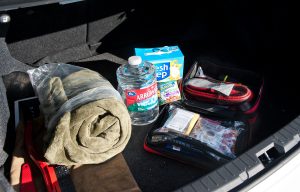This time of year, many of us are gearing up for the winter season, which can bring snow, ice, freezing temps, and much longer nights. Cold weather can do funny things to vehicles, but there are steps that can be taken to prepare for the season’s challenges. A few months ago, we looked at the best ways to prepare your vehicle for a summer road trip. As I write this, we’ve just had our first major snowfall in my part of New England, so let’s outline some of the best ways to get your vehicle ready for the winter season.
Check Your Tires

Tires are one of the most important parts of your vehicle and can drastically impact safety if they are not properly maintained or if the wrong tire is chosen for colder times of year. The rubbers that make up modern tires are specifically formulated for a desired level of performance, which can depend greatly on the operating temperatures that the tire is exposed to. Some tires are made and labeled as summer tires or sport tires, and the rubber in these products is made to provide maximum traction when the air and ground temperatures are well above freezing. Not only do these tires experience greatly reduced traction when the going gets colder, they may also have issues with braking, air retention, and balance.
Tread depth and wear are additional points of concern, as they should be any other time of year. Tread patterns in tires are designed to grip the road, some even specifically for snow, but when the tread is worn away or unevenly worn, it can cause huge problems with the car’s traction and stability in slippery conditions.
Inspect Your Battery
The battery is obviously a vital part of a vehicle’s operation, but what many people don’t know is that it can be greatly affected by temperature extremes in either direction. Vehicle batteries are essentially containers full of liquid (an electrolyte solution, to be scientific) and electrodes that charge the liquid to generate power.
Very warm temperatures can speed up those internal chemical reactions, causing batteries to lose capacity and lifespan more quickly. On the opposite end of the spectrum, cold weather slows the power-producing chemical reactions inside of batteries, which makes it more difficult to produce enough power to start the vehicle. Batteries are manufactured with a Cold Crank Amperage number, which rates the battery’s ability to produce power for up to 30 seconds in sub-freezing temperatures. The higher the number, the better the battery will perform in cold weather. Batteries that aren’t designed to work in colder temps may not be able to start a vehicle or may struggle to produce enough power to operate key functions while the vehicle is running.
Check Fluids
Just like the fluid inside of batteries, other liquids under the hood of your vehicle can be impacted by extreme temperatures:
Oil
Have you ever poured olive oil into a hot pan and noticed that it immediately becomes thinner, rolling around in the pan almost like water? Engine oil behaves almost the same way when exposed to heat by thinning and spreading out. The opposite is true when oils are exposed to colder temps. They become thicker (more viscous) and move more slowly inside the engine.
Thankfully, engine oils are manufactured with viscosity ratings that tell us how well they perform at different temperatures. The ratings, sometimes called grades, are structured to show viscosity at both cold and hot running temperatures. Oils with ratings like 0W-20 or 5W-30 are generally recommended for cold weather operation. The lower numbers in the first part of the ratings show that the oils are meant for vehicles in colder climates, because they resist thickening caused by lower temperatures. The second number represents the oil’s viscosity at hotter temperatures, so your vehicle may require different oil types as the seasons change during the year.
Washer Fluid
Here in New England, there are days after a big storm when the roads are covered in a mix of melted snow, sand, salt, and dirt churned up by the plows. This slurry of winter fun, combined with the freezing temperatures can make for a windshield that is not only dirty, but frozen for good measure. When this happens, a normal washer fluid can add to the party by freezing on top of the dirt already on the windshield. Thankfully, several companies make washer fluids that are designed to perform at low temperatures and may even help de-ice a windshield. In most cases, it’s fine to use this washer fluid year-round so there won’t be a need to switch over as the seasons change.
Winter Supplies
I have two kids, so I generally keep a bag full of wipes, paper towels, bandages, and other necessities in the trunk. In the winter, I add a blanket, an ice scraper, an extra jacket, and other supplies like a solar power converter to charge my phone.
This is a vital precaution to take in cold weather, even in areas where snow is rare. There are times when drivers may lose control of their vehicles and become stuck in places that are hard to access or the vehicle may break down in a remote area, and in these cases the winter supply kit can save lives and support the vehicle’s occupants until help can arrive.
Many people won’t have to worry about any of these challenges (looking at you, Southern California), but winter can bring some real headaches for the rest of us. Modern vehicles are designed to operate at the extremes of temperature and weather conditions, but they need a little help to perform at their best. Planning ahead and staying prepared for whatever the road may bring will help ensure a safe and enjoyable winter driving season.
(Article continues below)





